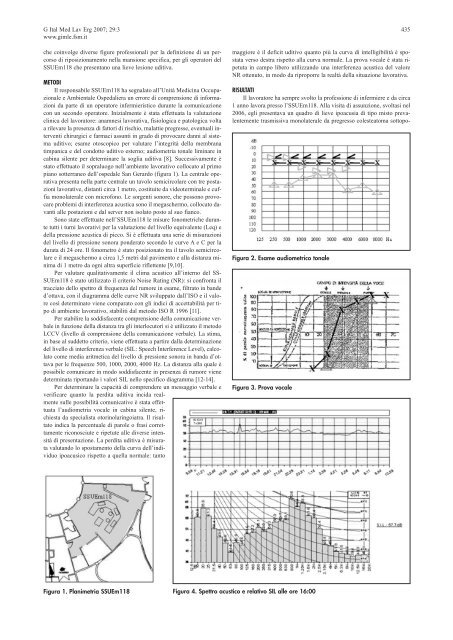Validazione di un algoritmo per la valutazione dei rischi da ...
Validazione di un algoritmo per la valutazione dei rischi da ...
Validazione di un algoritmo per la valutazione dei rischi da ...
You also want an ePaper? Increase the reach of your titles
YUMPU automatically turns print PDFs into web optimized ePapers that Google loves.
G Ital Med Lav Erg 2007; 29:3 435<br />
www.gimle.fsm.it<br />
che coinvolge <strong>di</strong>verse figure professionali <strong>per</strong> <strong>la</strong> definizione <strong>di</strong> <strong>un</strong> <strong>per</strong>corso<br />
<strong>di</strong> riposizionamento nel<strong>la</strong> mansione specifica, <strong>per</strong> gli o<strong>per</strong>atori del<br />
SSUEm118 che presentano <strong>un</strong>a lieve lesione u<strong>di</strong>tiva.<br />
METODI<br />
Il responsabile SSUEm118 ha segna<strong>la</strong>to all’Unità Me<strong>di</strong>cina Occupazionale<br />
e Ambientale Ospe<strong>da</strong>liera <strong>un</strong> errore <strong>di</strong> comprensione <strong>di</strong> informazioni<br />
<strong>da</strong> parte <strong>di</strong> <strong>un</strong> o<strong>per</strong>atore infermieristico durante <strong>la</strong> com<strong>un</strong>icazione<br />
con <strong>un</strong> secondo o<strong>per</strong>atore. Inizialmente è stata effettuata <strong>la</strong> <strong>valutazione</strong><br />
clinica del <strong>la</strong>voratore: anamnesi <strong>la</strong>vorativa, fisiologica e patologica volta<br />
a rilevare <strong>la</strong> presenza <strong>di</strong> fattori <strong>di</strong> <strong>rischi</strong>o, ma<strong>la</strong>ttie pregresse, eventuali interventi<br />
chirurgici e farmaci ass<strong>un</strong>ti in grado <strong>di</strong> provocare <strong>da</strong>nni al sistema<br />
u<strong>di</strong>tivo; esame otoscopico <strong>per</strong> valutare l’integrità del<strong>la</strong> membrana<br />
timpanica e del condotto u<strong>di</strong>tivo esterno; au<strong>di</strong>ometria tonale liminare in<br />
cabina silente <strong>per</strong> determinare <strong>la</strong> soglia u<strong>di</strong>tiva [8]. Successivamente è<br />
stato effettuato il sopraluogo nell’ambiente <strong>la</strong>vorativo collocato al primo<br />
piano sotterraneo dell’ospe<strong>da</strong>le San Gerardo (figura 1). La centrale o<strong>per</strong>ativa<br />
presenta nel<strong>la</strong> parte centrale <strong>un</strong> tavolo semicirco<strong>la</strong>re con tre postazioni<br />
<strong>la</strong>vorative, <strong>di</strong>stanti circa 1 metro, costituite <strong>da</strong> videoterminale e cuffia<br />
mono<strong>la</strong>terale con microfono. Le sorgenti sonore, che possono provocare<br />
problemi <strong>di</strong> interferenza acustica sono il megaschermo, collocato <strong>da</strong>vanti<br />
alle postazioni e <strong>da</strong>l server non iso<strong>la</strong>to posto al suo fianco.<br />
Sono state effettuate nell’SSUEm118 le misure fonometriche durante<br />
tutti i turni <strong>la</strong>vorativi <strong>per</strong> <strong>la</strong> <strong>valutazione</strong> del livello equivalente (Leq) e<br />
del<strong>la</strong> pressione acustica <strong>di</strong> picco. Si è effettuata <strong>un</strong>a serie <strong>di</strong> misurazioni<br />
del livello <strong>di</strong> pressione sonora ponderato secondo le curve A e C <strong>per</strong> <strong>la</strong><br />
durata <strong>di</strong> 24 ore. Il fonometro è stato posizionato tra il tavolo semicirco<strong>la</strong>re<br />
e il megaschermo a circa 1,5 metri <strong>da</strong>l pavimento e al<strong>la</strong> <strong>di</strong>stanza minima<br />
<strong>di</strong> 1 metro <strong>da</strong> ogni altra su<strong>per</strong>ficie riflettente [9,10].<br />
Per valutare qualitativamente il clima acustico all’interno del SS-<br />
SUEm118 è stato utilizzato il criterio Noise Rating (NR): si confronta il<br />
tracciato dello spettro <strong>di</strong> frequenza del rumore in esame, filtrato in bande<br />
d’ottava, con il <strong>di</strong>agramma delle curve NR sviluppato <strong>da</strong>ll’ISO e il valore<br />
così determinato viene comparato con gli in<strong>di</strong>ci <strong>di</strong> accettabilità <strong>per</strong> tipo<br />
<strong>di</strong> ambiente <strong>la</strong>vorativo, stabiliti <strong>da</strong>l metodo ISO R 1996 [11].<br />
Per stabilire <strong>la</strong> sod<strong>di</strong>sfacente comprensione del<strong>la</strong> com<strong>un</strong>icazione verbale<br />
in f<strong>un</strong>zione del<strong>la</strong> <strong>di</strong>stanza tra gli interlocutori si è utilizzato il metodo<br />
LCCV (livello <strong>di</strong> comprensione del<strong>la</strong> com<strong>un</strong>icazione verbale). La stima,<br />
in base al suddetto criterio, viene effettuata a partire <strong>da</strong>l<strong>la</strong> determinazione<br />
del livello <strong>di</strong> interferenza verbale (SIL: Speech Interference Level), calco<strong>la</strong>to<br />
come me<strong>di</strong>a aritmetica del livello <strong>di</strong> pressione sonora in ban<strong>da</strong> d’ottava<br />
<strong>per</strong> le frequenze 500, 1000, 2000, 4000 Hz. La <strong>di</strong>stanza al<strong>la</strong> quale è<br />
possibile com<strong>un</strong>icare in modo sod<strong>di</strong>sfacente in presenza <strong>di</strong> rumore viene<br />
determinata riportando i valori SIL nello specifico <strong>di</strong>agramma [12-14].<br />
Per determinare <strong>la</strong> capacità <strong>di</strong> comprendere <strong>un</strong> messaggio verbale e<br />
verificare quanto <strong>la</strong> <strong>per</strong><strong>di</strong>ta u<strong>di</strong>tiva inci<strong>da</strong> realmente<br />
sulle possibilità com<strong>un</strong>icative è stata effettuata<br />
l’au<strong>di</strong>ometria vocale in cabina silente, richiesta<br />
<strong>da</strong> specialista otorino<strong>la</strong>ringoiatra. Il risultato<br />
in<strong>di</strong>ca <strong>la</strong> <strong>per</strong>centuale <strong>di</strong> parole o frasi correttamente<br />
riconosciute e ripetute alle <strong>di</strong>verse intensità<br />
<strong>di</strong> presentazione. La <strong>per</strong><strong>di</strong>ta u<strong>di</strong>tiva è misurata<br />
valutando lo spostamento del<strong>la</strong> curva dell’in<strong>di</strong>viduo<br />
ipoacusico rispetto a quel<strong>la</strong> normale: tanto<br />
Figura 1. P<strong>la</strong>nimetria SSUEm118<br />
maggiore è il deficit u<strong>di</strong>tivo quanto più <strong>la</strong> curva <strong>di</strong> intelligibilità è spostata<br />
verso destra rispetto al<strong>la</strong> curva normale. La prova vocale è stata ripetuta<br />
in campo libero utilizzando <strong>un</strong>a interferenza acustica del valore<br />
NR ottenuto, in modo <strong>da</strong> riproporre <strong>la</strong> realtà del<strong>la</strong> situazione <strong>la</strong>vorativa.<br />
RISULTATI<br />
Il <strong>la</strong>voratore ha sempre svolto <strong>la</strong> professione <strong>di</strong> infermiere e <strong>da</strong> circa<br />
1 anno <strong>la</strong>vora presso l’SSUEm118. Al<strong>la</strong> visita <strong>di</strong> ass<strong>un</strong>zione, svoltasi nel<br />
2006, egli presentava <strong>un</strong> quadro <strong>di</strong> lieve ipoacusia <strong>di</strong> tipo misto prevalentemente<br />
trasmissiva mono<strong>la</strong>terale <strong>da</strong> pregresso colesteatoma sottopo-<br />
Figura 2. Esame au<strong>di</strong>ometrico tonale<br />
Figura 3. Prova vocale<br />
Figura 4. Spettro acustico e re<strong>la</strong>tivo SIL alle ore 16:00
















